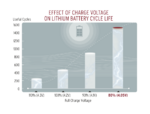2 years until obsolescence of the bike itself seems a bit short. There would be better batteries and (slightly) improved motors in 2 years, but unlikely any major break-through in mechanical parts, or such a break-through might not be worth paying for, if the old mechanicals still work.
According to Grin Technologies, keeping battery in 20-80% extends its life quite significantly, from 2 to 5 years if memory doesn't fail me. Though I wouldn't expect a bike bought today to become really obsolete in 5 years either, i.e. the bike itself. Btw, they sell programmable chargers that can be set to 80 or 90%. Luna have some too, at (much) lower cost, though without a cool display.

